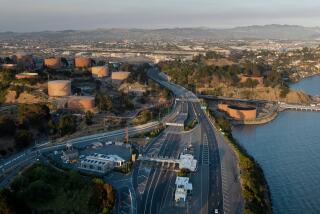Chevron to Pump Billions Into Tengiz
- Share via
Chevron Corp. said Monday that its joint venture with Kazakhstan to develop one of the world’s largest oil fields could produce 700,000 barrels of oil a day and involve a joint investment of $20 billion over 40 years.
Earlier this month, Chevron and the former Soviet republic announced a preliminary agreement to develop the Tengiz and Korolev fields, estimated to be even bigger than Alaska’s Prudhoe Bay.
At a Washington news conference Monday, Kazakhstan President Nursultan Nazarbayev and Chevron Chairman Kenneth T. Derr announced further details of the project and said they hope to conclude a final agreement by Jan. 1.
“If it pays off--and that’s a big if-- it could be a company-making investment, even for a company as big as Chevron,” said Philip K. Verleger Jr., an energy economist with the Institute for International Economics in Washington.
“If it’s successful, Chevron will be a much, much larger company. But it’s just a big gamble,” Verleger added.
The project was stalled for nearly four years until the surprise announcement of an preliminary agreement 10 days ago. It was one of the earliest proposals for a joint venture between U.S. oil companies, with their advanced technologies, and the fledgling republics of the former Soviet Union,
“It’s the bellwether deal, in that this is the first big deal,” said Daniel Yergin, president of Cambridge Energy Research Associates.
“The significance of this is beyond oil. . . . The republics really need help, and helping them to rehabilitate their oil and gas industry is the most important step to bringing them into the world economy,” said Yergin, the Pulitzer-winning author of “The Prize: the Epic Quest for Oil, Money and Power.”
The 40-year agreement calls for a $1.5-billion investment in the first three years and $20 billion over the life of the project--split equally between Chevron and Kazakhstan.
While the two partners will share equally in the oil produced, the taxes and royalties to be paid to Kazakhstan on Chevron’s share will make the actual distribution of income closer to 80% for Kazakhstan and 20% for Chevron.
The fields now produce about 60,000 barrels a day. Under the joint venture, to be named Tengizchevroil, the partners hope to produce 700,000 barrels daily by the year 2010. The project will require 600 wells, many to be drilled using such U.S. innovations as horizontal drilling.
The Tengiz is known in the oil industry as a super-giant, or elephant field. Prudhoe Bay, the largest U.S. field--also a super-giant--was estimated to have reserves in the ground of 22 billion barrels when it was discovered in 1968. Tengiz and the adjacent Korolev fields have estimated reserves of 25 billion barrels.
More to Read
Inside the business of entertainment
The Wide Shot brings you news, analysis and insights on everything from streaming wars to production — and what it all means for the future.
You may occasionally receive promotional content from the Los Angeles Times.










